John Thomas Redmayne, 1846-1880
by Brian Stevenson
last updated November, 2017
J.T.
Redmayne was a surgeon and physician, and an amateur naturalist specializing in
diatoms. His microscope slides of diatoms were very well regarded in his time,
notably for their relative purity of species (Figure 1 and 2). He also mounted
histological preparations, a logical extension of his occupation, although such
slides are rarely encountered today.
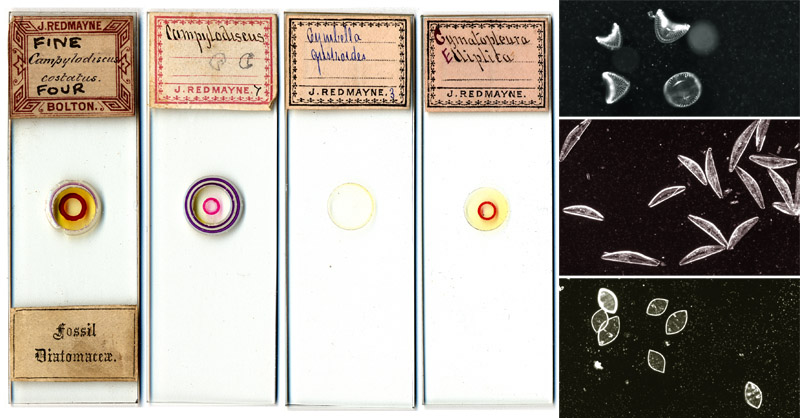
Figure 1.
Examples of selected diatom slides by J. Redmayne.
They contain from four to a few dozen selected frustules, loosely arrayed in
the center of the slide. Although the diatoms were not artistically arranged
like those of contemporaries such as Laurence Hardman, Redmayne’s mounts give
views of the diatoms from multiple angles, highly desirable for biologists interested
in diatom structure. At the right, top to bottom, are darkfield images of
Redmayne’s Campylodiscus cestatus, Cymbella sp., and Cymatopleura elliptica. Photographed
with colored filters. Note that Redmayne used a variety of handwriting styles on
his labels.
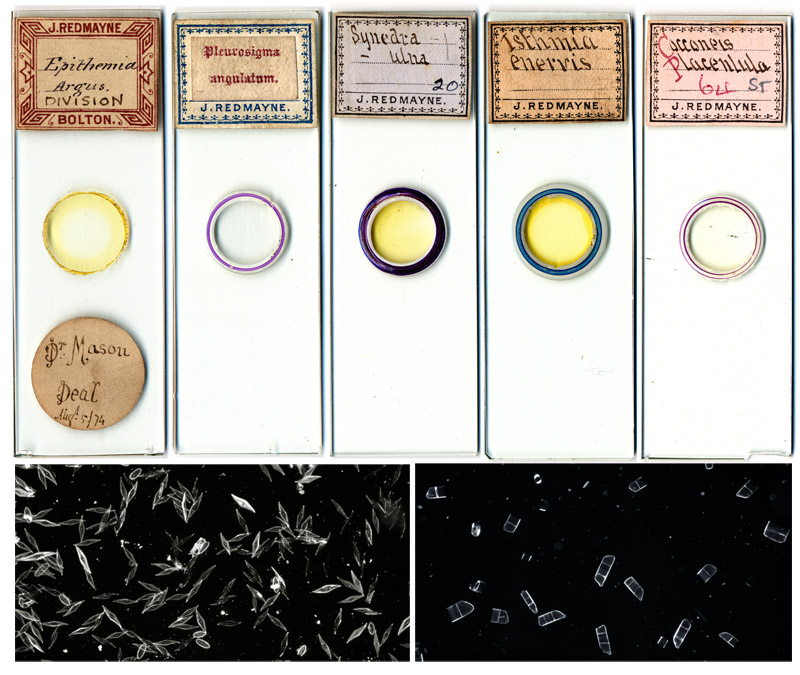
Figure 2.
Strewn diatom slides by John Redmayne, each of which
contains hundreds of diatoms spread evenly under the coverslip. Shown below the
slides are, left to right, a gathering of Pleurosigma angulatum mixed with
small numbers of other species, and a pure gathering of Isthmia enervis.
John
Thomas Redmayne was born during the first quarter of 1846 near Horton,
Yorkshire. He was the first child of William and Isabella Redmayne. William
operated a 120 acre farm named “Gallabar”.
There is some confusion among genealogies posted on the internet, with some
family trees suggesting that our J.T. Redmayne’s parents were another farming
couple named John and Margaret. However, the 1878 marriage record of the John
Thomas Redmayne born to John and Margaret indicates that he was not our
microscopist. Such confusions are common in genealogical research, as families
tended to recycle a very few ancestral names.
By 1861,
the Redmaynes had moved to Clitheroe, Lancashire, where William operated a wine
shop. Such businesses were usually profitable, and probably helped finance
John’s medical education.
In
September, 1864, John Redmayne passed his preliminary examinations at the
Faculty of Physicians and Surgeons, Glasgow. He continued his studies at Guy’s
Hospital, London, receiving his diploma and admittance to the Royal College of
Surgeons in January, 1869.
John
married Sarah Fielden Hyatt during the summer of 1870. They set up house in
Bolton, Lancashire shortly thereafter. Apparently, Redmayne took additional
classes in Edinburgh around that time, as he reported having received a License
in 1873 from the Royal College of Physicians, Edinburgh.
Redmayne
evidently developed an interest in diatoms and making slides prior to 1874. In
August of that year, he advertised in the popular magazine Hardwicke’s Science-Gossip to exchange “good slides” of diatoms with other microscopists (Figure 3). The following year he offered to exchange “pure
gatherings prepared” of diatoms.

Figure 3.
Exchange offers advertised by John Redmayne in ‘Hardwicke’s Science-Gossip’.
George E.
Davis, in his 1889 Practical Microscopy,
gave high ratings to Redmayne’s diatom slides, “Cleaning the Specimens - This is a section upon which a
moderate-sized volume may be written, as it applies to all objects whether
mounted dry, in gum resins, or in aqueous media, and may simply be described as
an operation for eliminating matter in the wrong place - dirt. Foreign matters
should be eliminated as much as possible, and really, when set about in the
right way, it is not very difficult. When we come to compare the slides of
diatoms put up by Cole, Redfern, or Redmayne, with
many home-mounted slides it may be readily seen what is the effect of a little
care on the part of the preparer. Cole's exceedingly clean gatherings, his
hand-picked slides, Redfern's single diatom, mounted
on a 1/4-inch cover in the centre of a red circle 1/16 of an inch in diameter,
and Redmayne's diatom slides all deserve imitation.”
Redmayne
described a device he invented for the collection of diatoms, in the July, 1875
issue of Hardwicke’s Science-Gossip.
This invention was widely reprinted throughout the world.
“As the beauty of mounted diatoms depends in
a great measure on the cleanliness of the original gathering, sand and other
impurities being difficult to get rid of in after-manipulation, I have found
the following addition to the ordinary collecting apparatus, of very great
assistance. It has the advantage of being easily made, and with its aid much
better results can be obtained than by any other means.
A cork must be provided which fits tightly to the
collecting-bottle; this is to be bored with two holes; in each is fitted a
glass tube, as seen in the diagram, one (a) having a slight curve, the other (b) bent at right angles an inch from
the end; this can easily be done with the aid of a spirit-lamp. To tube b is attached a piece of elastic
tubing, about the length of the collecting-stick, and the free end (c) may be
held to the stick with an elastic band, and the apparatus is complete.
It is especially useful in collecting the very thin
films of diatoms from the surfaces of mud and sand, so difficult to raise to
the surface of the water in the ordinary way with the spoon or bottle.
To use the apparatus, the thumb of the right hand
must press the tube firmly against the stick at c, and the bottle lowered until the mouth of the tube (a) is
within a quarter of an inch from the surface of the diatoms; the thumb is then
to be raised, and if the water is deep, the bottle will fill by atmospheric
pressure, carrying the diatoms in at the same time. In shallow water suction
will be necessary to exhaust the air in the bottle: in that case a ball pipette
(fig. B) will be useful as a mouthpiece.
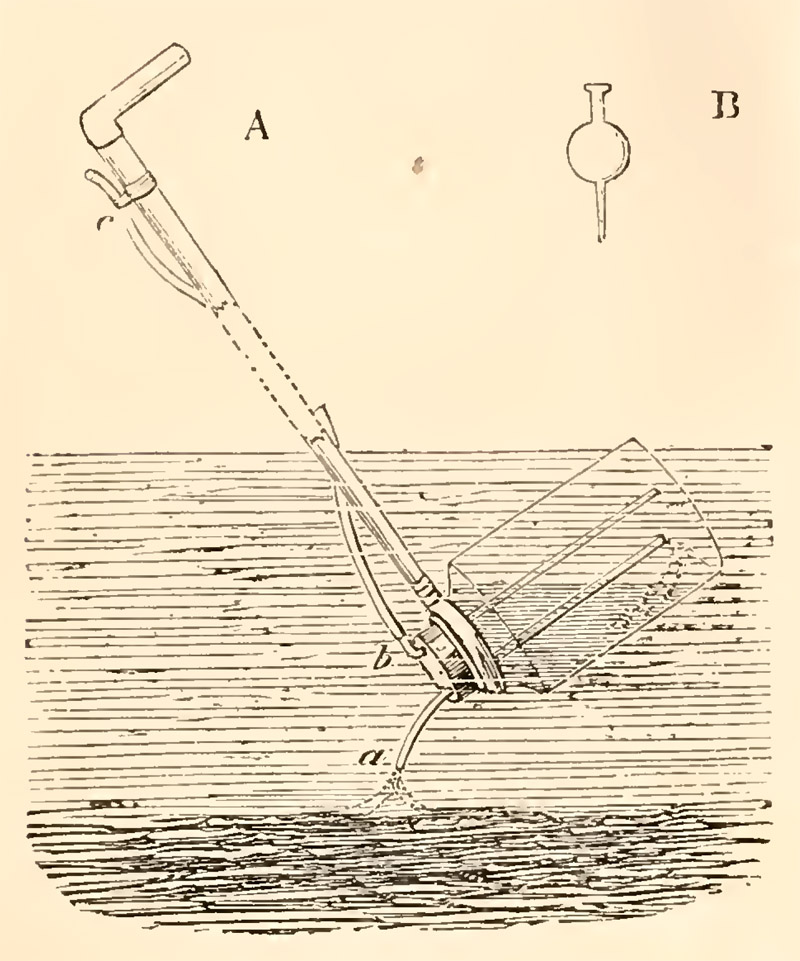
Figure 4.
Redmayne’s diatom collecting device. From ‘Hardwicke’s Science-Gossip’, 1876.
During 1877, Redmayne self-published a book of photomicrographs of diatoms. The
subjects were mostly from a J.D. Möller Typen
Platte. In all, there were 65 photographs. In 1878, he offered copies of
his book in exchange for a good microscope objective lens or slides (Figure 3).
George Davis wrote in 1881 that, “the
most successful photographers of microscopic objects have been Col. Woodward,
Dr. Maddox, Mr. Wenham, Drs. Abercrombie and Wilson, Mr. Shadbolt, and the late
Dr. Redmayne, of Bolton”. Davis also remarked
that copies of Redmayne’s photographs could be obtained from Edward Ward’s shop
in Manchester. G.J. Johnson wrote in 1883, after describing the photomicrographs
of Fritsch and Müller, that “these
examples of the German photographers, however, do not in any way exceed in
beauty the work privately published by my late lamented friend, Dr. Redmayne,
of Bolton.”
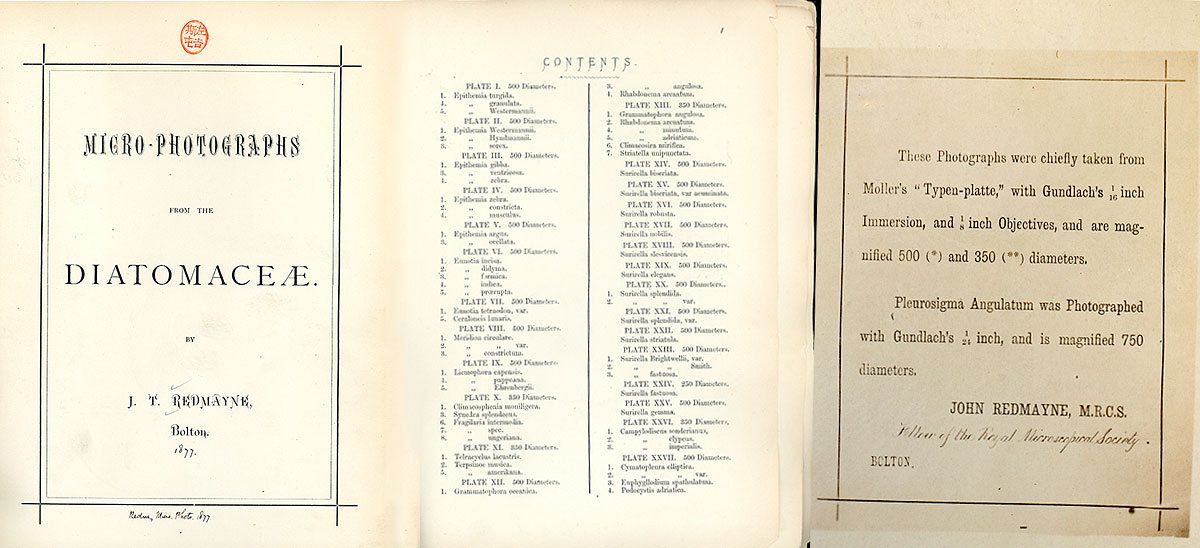
Figure 5.
Front page, table of contents, and technical details from Redmayne’s 1877 book of diatom photomicrographs. Adapted with permission from http://www.canadiannaturephotographer.com/Redmayne_diatoms.html.

Figure 6.
Plate 50, Pleurosigma angulatum, magnified 750x, by John Redmayne. Additional photographs from his 1877 book are reproduced in Figures 8-11, at the end of this essay, and at http://www.canadiannaturephotographer.com/Redmayne_diatoms.html. Image adapted with permission of Robert Berdan.
Redmayne
donated copies of his book to the Quekett Microscopical Club (which he joined
in 1876) and the Royal Microscopical Society (which he joined in 1877).
Redmayne also helped found the Bolton Microscopical Society, in 1877.
John
Thomas Redmayne died after a long illness on September 10, 1880, at the age of
only 34. One of the executors of his estate, John Francis Walkingame Tatham,
was later a President of the Manchester Microscopical Society. Intriguingly, although
the Redmaynes were Quakers (Society of Friends), Sarah Redmayne was baptized in
the Anglican church of All Souls, Bolton, on February 25, 1880.
The 1881
Royal Microscopical Society President’s Address, given by Lionel Beale,
included a brief, inaccurate eulogy of Redmayne. “John Thomas Redmayne, of Bolton, L.R.C.P. Edin., M.R.C.S., died in
October last at the age of thirty-three. One who was well acquainted with him
says that he was a most skilful microscopist, and devotedly fond of the work. He was also an excellent microphotographer. The
Bolton Microscopical Society was founded by Mr. Redmayne, and, as his friend
remarks, had he lived he would undoubtedly have taken a high place in the
scientific world.”
Far better commentaries on John Redmayne and his microscopy work were published by those who actually knew the man:
The Northern Microscopist report of
the November 19, 1880 Annual Conversazione of the Bolton Microscopical Society
stated, “The table possessing a feature
of melancholy interest was that covered with the microscopes and rich work of
the late Dr. Redmayne, one of the founders of this
Society. The presence of his photo-micrographs, the varied assortment of
pathological preparations and rare diatoms made it hard to believe that he was
not present also.“
At the
Conversazione, the Society’s Secretary, William Rideout, delivered the
following words, “I cannot close my
review of the work of the Society without referring to the great loss which we,
as a Society, have sustained by the long illness and death of our talented and
much-lamented treasurer, Dr. Redmayne. During the whole time since the
formation of the Society he had its well-being at heart, and few knew better
than myself how deeply he regretted that he was prevented from assisting in the
work of the Society by his failing health. I am sure that each member of the
Society felt that he had lost a dear friend when he heard that the doctor was
no more. His pleasant smile and genial manner will long be remembered by us,
and failing this his name will live as the founder of the Bolton Microscopical
Society.”
The Northern Microscopist also
reported, in the summer of 1881, “Bolton
Microscopical Society - Although this Society enjoys a Summer holiday during
the months of June, July, and August, the work is not entirely suspended, for
the valuable collection of Slides now in possession of the Society is being
re-arranged owing to several recent additions; the
most noticeable of which is the gift of six dozen choice Slides by Mrs. Redmayne, from the valuable collection of the late Dr Redmayne, the founder of the Society. In order that the
most suitable selection might be made, Mrs. Redmayne
kindly placed the whole collection in the hands of the President and the
Secretary of the Society for this purpose. Forty eight choice Slides of Diatoms
have also been added, so that the members to whom the Slides are lent, will
have ample occupation for leisure hours during the winter evenings.”
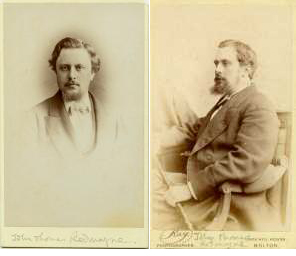
Figure 7.
Undated photographs of John Thomas Redmayne. Adapted for non-profit, educational use from http://family.manvell.org.uk/redmayne.htm.
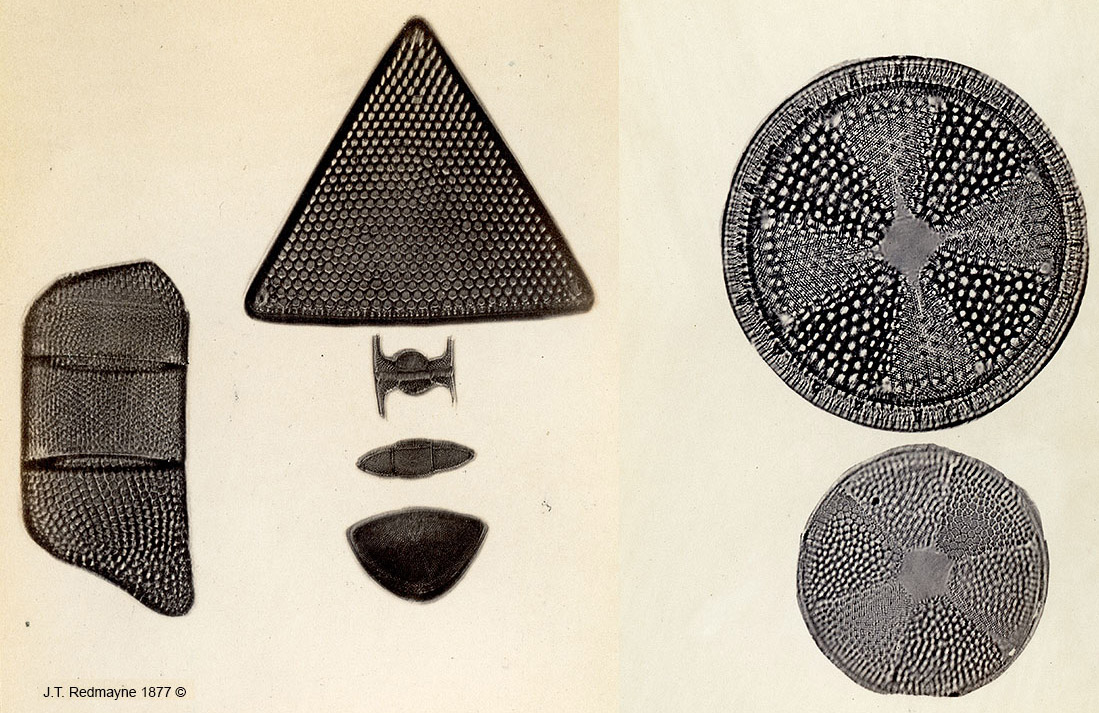
Figure 8.
Left: Plate 55, Actinosphenia halionyx, and Actionsphenia spendens, 500x. Right: Plate 78, Heliopelta and Actinoptychus undulatus, 500x. Adapted with permission, from http://www.canadiannaturephotographer.com/Redmayne_diatoms.html.
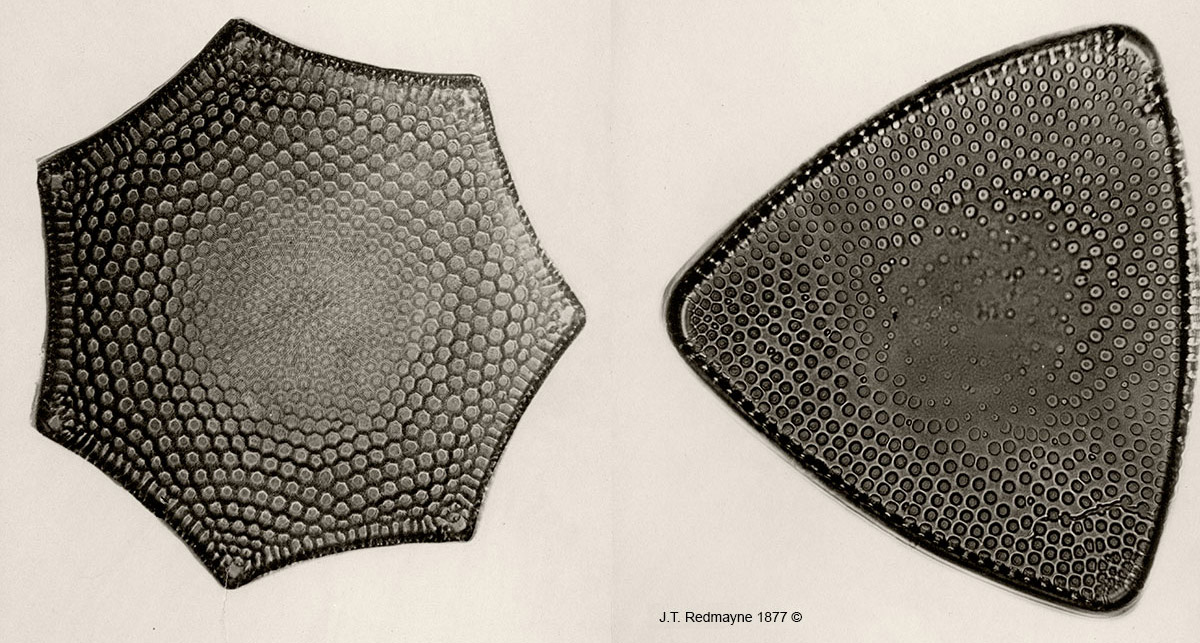
Figure 9.
Left: Plate 58, Triceratum favus var spetanghulatum, 500x. Right: Plate 59, Triceratum inflatum, 500x. Adapted with permission, from http://www.canadiannaturephotographer.com/Redmayne_diatoms.html.
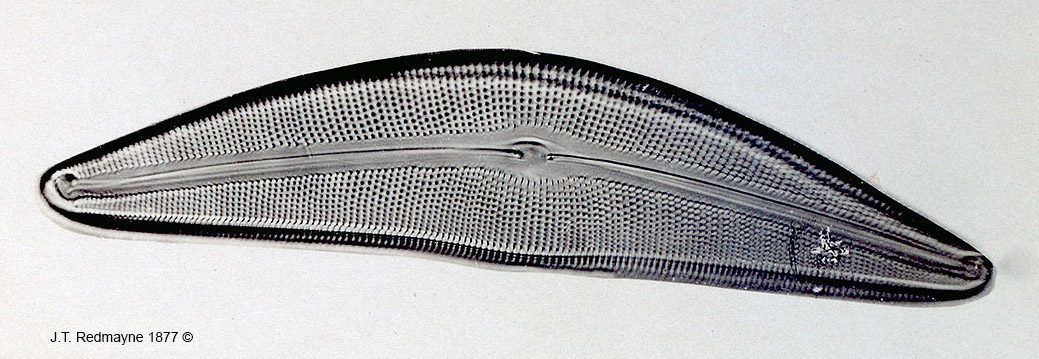
Figure 10.
Plate 31, Cymbella gastroides, 500x. Adapted with permission, from http://www.canadiannaturephotographer.com/Redmayne_diatoms.html.
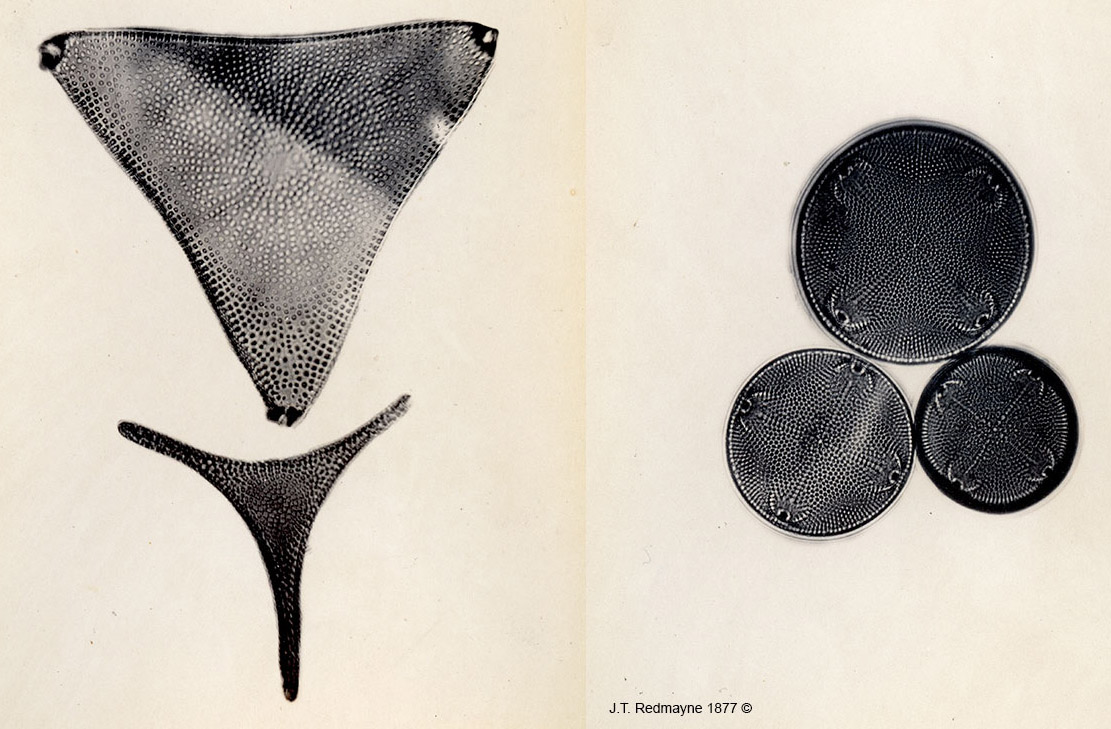
Figure 11.
Left: Plate 63, Trinacria regina and Trinacria excavata, 500x. Right: Plate 64, Hemialus alatus and Actinocyclus ralfsii, 500x. Adapted with permission, from http://www.canadiannaturephotographer.com/Redmayne_diatoms.html.
Acknowledgements
Thank you to Robert Berdan, for sharing images of John Redmayne’s book of diatom photographs, and for generously providing permission to use some in this page.
Resources
The American Naturalist (1876) Collecting diatoms, Vol. 10, page 567.
Baptism record of Sarah Fielden Hyatt Redmayne (1880) All Souls Church, Bolton, accessed through The Lancashire OnLine Parish Clerks Project,
http://www.lan-opc.org.uk/Bolton-le-Moors/Little-Bolton/allsouls/baptisms_1879-1888.html
Berdan, Robert (accessed 2017) Photomicrographs of Diatoms from 1877 by John T. Redmayne, http://www.canadiannaturephotographer.com/Redmayne_diatoms.html.
Bracegirdle, Brian (1998) Microscopical Mounts and Mounters, Quekett Microscopical Society, London, pages 79, 164 and 166, plate 30 slide N and plate 31 slides C and D.
Davis, George E. (1881) Photo-micrography, Northern Microscopist, Vol. 1, pages 73-82.
Davis, George E. (1889) Practical Microscopy, W.H. Allen & Co., London, pages 184 and 384.
English
census, birth, marriage and death records, accessed through ancestry.co.uk.
Hardwicke’s Science-Gossip (1874)
Exchange offer from J. Redmayne, Vol. 10, page 192.
Hardwicke’s Science-Gossip (1875)
Exchange offer from J. Redmayne, Vol. 11, page 240.
Hardwicke’s Science-Gossip (1878)
Exchange offer from J. Redmayne, Vol. 14, page 168.
http://family.manvell.org.uk/redmayne.htm
(accessed December, 2012) Photographs of John Redmayne and family.
Johnson,
G.J. (1883) Photomicrography, The
Microscopical News and Northern Microscopist, Vol. 3, pages 113-121.
Journal of the Quekett Microscopical Club (1876)
Admittance of John T. Redmayne, Vol. 4, page 201.
Journal of the Quekett Microscopical Club (1876)
Donation of “An album of Micro-Photographs of Diatomaceae” by Mr. J. Redmayne, Vol. 4, page 240.
Journal of the Royal Microscopical Society (1877)
Membership list, Vol. 2, page liv.
Journal of the Royal Microscopical Society (1881)
President’s Address, Series 2, Vol. 1, pages 180-181.
The Lancet (1864) Faculty of Physicians and
Surgeons of Glasgow, Preliminary Examinations, Vol. 2, October 15 Advertiser
section.
Marriage
record of one John Redmayne and Anne Barrett (1878) Information concluding that
diatomist J.T. Redmayne was not the child of John and Margaret Redmayne, Parish
records of Kirkby Overblow, accessed through ancestry.co.uk.
The Medical Press and Circular (1867)
Royal College of Surgeons of England – results of examinations, May 22, pages
497-498.
The Medical Press and Circular (1869)
Royal College of Surgeons of England – diplomas and new members, January 27,
page 75.
The Medical Register (1874) Redmayne
John Thomas, Astley bank, Bolton, Lancashire, Mem. R. Coll. Surg. Eng. 1869, Lic.
R. Coll. Phys. Edin. 1873, page 422.
The Medical Times and Gazette (1867) Royal
College of Surgeons of England – results of examinations, Vol. 1, pages
538-539.
The Monthly Microscopical Journal (1877)
Donation to the Royal Microscopical Society of “Micro-photographs from the Diatomaceae, By J. Redmayne”, Vol. 17, page 222.
Museum of
the History of Science Collection Records (accessed December, 2012), “Published Album of Photographs (Albumen
Prints, Photomicrographs) of Diatoms, by John Redmayne, Bolton, c.1878”,
described as “John Redmayne,
Micro-Photographs from the Diatomaceae (Bolton, privately published, undated).
Bound in dark blue-green cloth. Flyleaf + printed introduction leaf + blank
leaf + 65 heavy paper leaves each with a mounted photograph + flyleaf. Thus
contains only 1 page of introductory text, and 65 photographs (albumen prints)
of diatoms, each captioned by a printed label on the mount. The photographs are
mostly brown with pale yellow backgrounds, and some are lilac colour; they are
all just under 5 x 4 inches. John Redmayne was elected to the Royal
Microscopical Society in 1877, but recorded in their membership list as dead in
October 1880. He lived at Bolton and was a surgeon, being a member of the Royal
College of Surgeons of Edinburgh. The diatoms photographed were mostly from J.
D. Möller's Typen-Platte, a prepared collection of specimens mounted on
microscope slides. Redmayne's volume was presumably acquired by the society at
the time it was issued, and a manuscript description of the diatoms depicted,
by E. W. Burgess, dated 1882, was also formerly in the RMS library.”,
https://www.mhs.ox.ac.uk/collections/search/displayrecord/?mode=displaymixed&module=ecatalogue&irn=29170
Nonie
family tree (accessed December, 2012) Information concluding that diatomist/surgeon
John Thomas Redmayne was not the child of John and Margaret Redmayne,
http://trees.ancestry.co.uk/tree/21397784/person/18618218503?ssrc=
The Northern Microscopist (1881)
Notices of Meetings – Bolton Microscopical Society, Vol. 1, pages 12-13.
The Northern Microscopist (1881)
Bolton Microscopical Society, Vol. 1, page 167.
Probate record of the Will of John Thomas Redmayne (1880) accessed through ancestry.co.uk.
Redmayne, John (1875) Diatom collecting, Hardwicke’s Science-Gossip, Vol. 11, page 152.
Redmayne, John (1877) Micro-photographs from the diatomaceae, Redmayne, Bolton.
Taylor, John E. (1889) The Playtime Naturalist, Appleton & Co., New York, pages 258-261.










